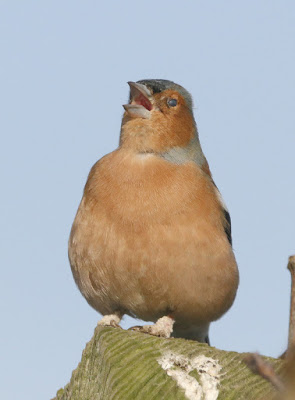Last summer, autumn and now the current winter will be memorable for all the wrong reasons. A series of storms and hurricane remnants battered the west coast of Britain. Our garden developed a sponge like consistency that became a no-go area; not that there were any birds to see or catch. Even the normally resilient band of Goldfinches seemed to depart, and birds which might otherwise winter with us were displaced elsewhere.
Only now with the lengthening days and the first signs of are some birds beginning to return. I had net up for a few hours and caught 5 new Goldfinch, a Chaffinch and a Collared Dove to kick off the garden ringing for 2018.
Goldfinch
Collared Dove
Chaffinch
Today I took a run out to some local spots and to drop seed at two ringing spots. Gulf Lane held about 90 Linnet, 6 Skylark, 5 Stock Dove, 1 Little Egret and 1 Grey Heron.
There’d been an overnight frost and the heron was waiting for the ditch to clear of ice.
Grey Heron
The flood at Rawcliffe Moss had muddy if slightly frozen margins edges to accommodate 16 Pied Wagtails, 6 Meadow Pipits, 2 Shelduck and 15 Lapwing. Later I would see Lapwings in display; a sure sign that spring is here at last.
Alongside the road a Chaffinch was in full song. I didn’t realise until I looked at the picture but the Chaffinch has diseased legs and feet, a condition known as Chaffinch Viral Papilloma (CVP).
Chaffinch
CVP is thought to affect around 1% of the Chaffinch population at any given time and can affect both sexes. Cases usually occur in clusters and quite high proportions of local populations may be affected in outbreaks. In my experience the disease is associated with Chaffinches that feed in farmyard, and smallholdings and where chickens roam freely.
The disease causes wart-like growths on the foot or tarsometatarsus, the bare part of the leg. The growths vary from small nodules to large irregular shaped and deeply-fissured masses which almost engulf the entire lower leg and foot. Affected birds usually seem in otherwise good health but some may show signs of lameness and hop mainly on the unaffected foot and digits may be lost. The disease can spread to other ground feeding birds like Dunnock.
At Conder Green I counted 80 Teal, 42 Wigeon, 24 Tufted Duck, 4 Shelduck, 28 Oystercatchers (inc 4 pairs), 26 Curlew, 18 Black-tailed Godwit and 14 Redshank.
A visit to our second Linnet site found 90+ Linnets still around together with 3 Meadow Pipit and 2 Reed Bunting. A Raven croaked overhead heading down to the Lune marshes – the species is now a common sight and sound in this area.
I saw a number of Brown Hares sitting out in the early sun and they don’t yet appear ready to start their boxing courtships. The hare is a beautiful and intriguing creature that against the odds of agricultural changes has managed to maintain a strong presence in this part of Lancashire. Unlike rabbits, hares do not make an underground warren but nest in a depression in the ground where their young are active as soon as they are born. I know a local farmer who swears that come summertime the local Buzzard population takes a heavy toll on the young hares (leverets).
Brown Hares
Brown Hares
The wintering Whooper Swans are now well spread across a couple of miles of fields, unlike early winter where for a few weeks after their arrival they stuck together like glue. There are probably still a couple of hundred Whooper Swans, up to 10 Bewick’s Swans and many Mute Swans but today I spotted an unusual interloper that seems to have escaped attention, a Black Swan.
Black Swan
Whooper Swan
Linking today to World Bird Wednesday, Anni's Birding and Eileen's blog

















































